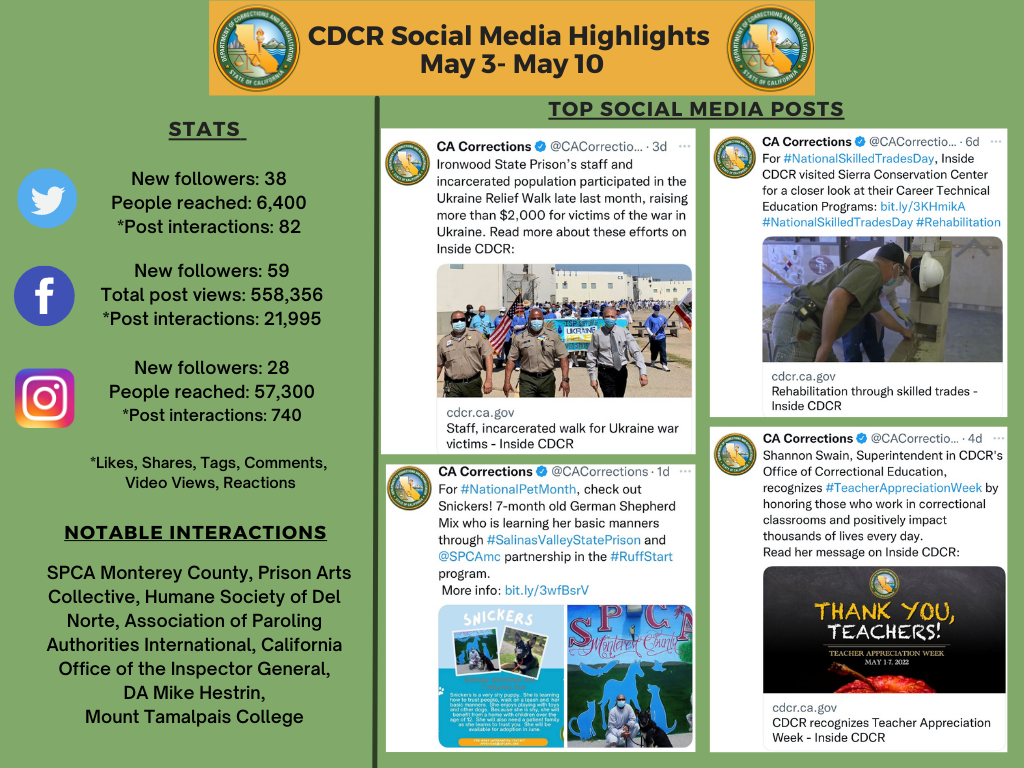What’s New
May Revise budget released
This morning, Governor Newsom released the May Revise of the 2022-23 state budget.
This is a step in the budgetary process, which will now go through the Legislative process and analysis.
For additional information, please see the Governor’s May Revise Summary. The CDCR summary starts on page 115.
CDCR, 12 state agencies host law enforcement career fair
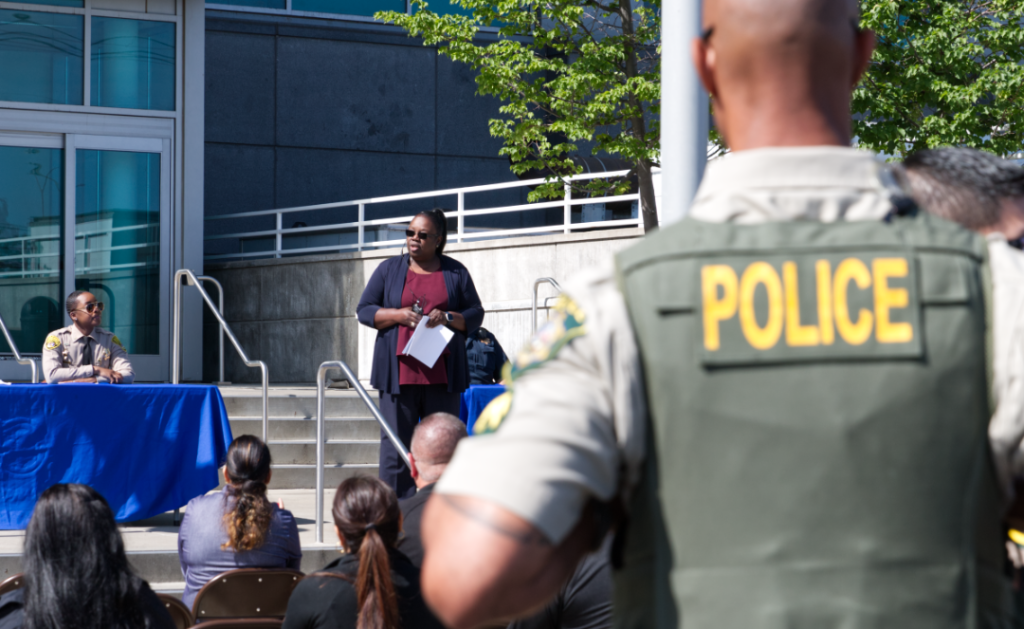
CDCR recently teamed up with 12 state agencies to showcase the benefits of a career in law enforcement. At the one-stop recruitment fair, held at the Department of Motor Vehicles headquarters in Sacramento on May 7, representatives answered questions from visitors and provided information about job openings in their departments statewide. Several booths offered equipment demonstrations, including state patrol vehicles and interactions with K-9 teams. Family-friendly activities like remote-control cars and animals entertained children while parents discussed career opportunities.
Connie Gipson, Director of CDCR Division of Adult Institutions, praised those who currently work or are interested in a career in law enforcement.
“When you say you want a career in law enforcement, what you’re really saying is you want to be a public servant. You’re part of something bigger than yourself,” Gipson said.
Observances
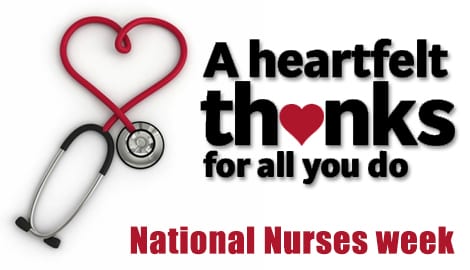
CDCR, CCHCS recognize National Nurses Week 2022
In honor of National Nurses Week 2022, Barbara Barney-Knox, Deputy Director, CCHCS Nursing Services, penned a letter of appreciation to the many nurses who save lives every day.
“We appreciate our nurses 365 days per year and this week we celebrate you and all that you do,” she wrote. “Each of you raise the bar in new ways every day by creating strong teams and working in service to others. It is your passion and hard work that will help us continue to shape the future of correctional health care.”
May is Mental Health Awareness Month
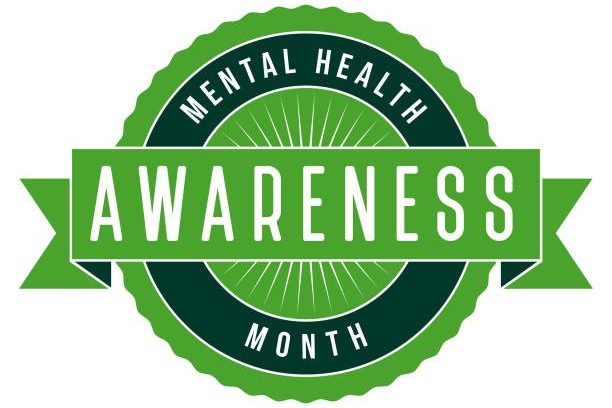
Mental Health Awareness Month was started in 1949 by Mental Health America, and each year the organization chooses a theme. The theme for 2022 is Back to Basics, the goal is to provide foundational knowledge about mental health and mental health conditions and information about what people can do if their mental health is a cause for concern.
Mental Health Awareness Month is recognized every year to normalize talking about mental health and share resources to support your mental well-being. Mental health conditions are more common than you might realize. According to GoodRx Health, an estimated 53 million people in the United States live with a mental illness, which is about 21% of the adult population. Included in that is 6% of adults who experience serious mental illness. About 17% of youth ages 6 to 17 years old experience mental health issues. Anxiety disorders are the most commonly diagnosed mental health conditions, affecting about 18% of the population. Other common mental health conditions include:
- Depression
- Post-traumatic stress disorder (PTSD)
- Bipolar disorder
- Schizophrenia
- Eating disorders
Effective treatments are available if you’re struggling with your mental health, and many organizations can provide information, support, and crisis intervention. Mental Health Awareness Month, which is in May, is designed to highlight the importance of taking care of your mental wellness. It’s also a great time to share valuable resources and learn where you can get mental health support. If you or someone you know is struggling with mental health issues, the following options are a consideration:
- Group therapy
- Individual counseling
- Mental health education
- Peer support groups
- Inpatient care at a treatment center, hospital, or residential program
3 Questions With..
Stephanie Griffone, Chief Psychologist, California Institution for Women
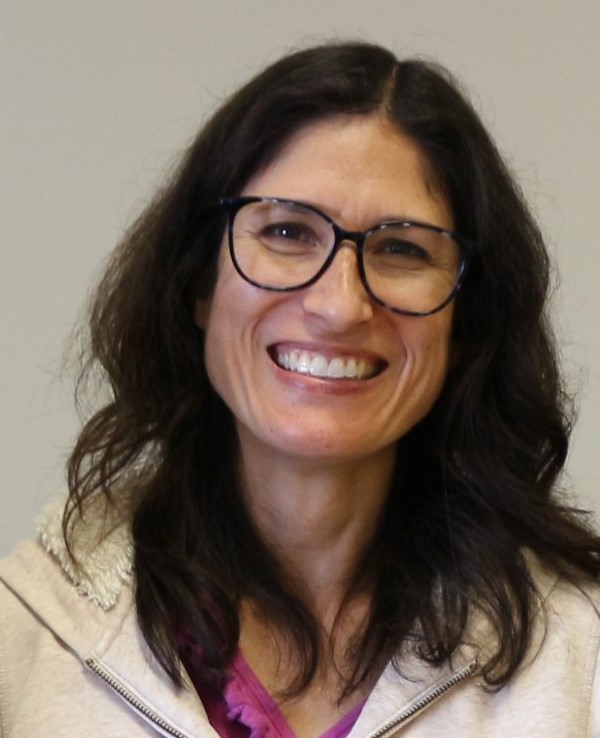
Stephanie Griffone, PhD, is a clinical psychologist at California Institution for Women (CIW). She started her career with CDCR by working for the Division of Juvenile Justice (DJJ) in 2006 at the Heman G. Stark Youth Correctional Facility. When the facility closed in 2010, she transferred to CIW and has been there since, where she is now a lead for the Psychiatric In-Patient Program (PIP).
What path led you to working in the PIP at CIW?
I was hired by DJJ when I was finishing my doctorate in Clinical Psychology, and as soon as my degree posted, I began working at the Heman G. Stark Youth Correctional Facility in Chino in June of 2006. I worked in the Intensive Treatment Program, which is similar to the Enhanced Outpatient level of care in CDCR, and I really enjoyed working there. On one memorable Sunday, one of the wards had climbed up on the roof of a two-story housing unit; despite the noise from the air show that day at the airport across the street, I was able to help persuade him to remove the torn sheet from his neck and safely come down. As the population of DJJ decreased, the decision was made to close the facility, and I was transferred to CIW in February of 2010.
I worked in the Administrative Segregation Unit (AdSeg) and saw quite a few changes during my three and a half years there. For example, during Realignment, when Valley State Prison for Women became Valley State Prison (VSP), the Security Housing Unit (SHU) was moved to CIW, serving both AdSeg and SHU populations. Also, Non-Disciplinary Segregation and Short-Term/Long-Term Restricted Housing Units were just starting to be developed and implemented when I was transferred to the CIW PIP in August of 2013, where I have been ever since
What is PIP and how would you describe some of the daily life working there?
The PIP is the Psychiatric Inpatient Program – it is like a state hospital level of care, but within CDCR and run by CDCR. The CIW PIP is a 45-bed building on the grounds at CIW. The patients who are treated here are kept separate from the rest of the prison, with most experiencing serious mental illness that has significantly impaired their functioning (schizophrenia, bipolar disorder, or major depressive disorder), and/or have harmed themselves or tried to kill themselves, and/or have harmed other people.
When I started in the PIP, it had been open for about 13 months. There have been a lot of changes in this PIP, and as the only PIP in a women’s facility, we have had to find ways to provide treatment for people at a variety of custody levels, which has required some creative problem-solving skills by all, including administration, clinical staff, nursing staff, and custody staff. My day usually starts by reading reports for the previous 24 hours, compiled by the Supervising Psychiatric Technicians with input from nursing, custody, and clinical staff on events and changes throughout the day. If there have been any incidents of minor misbehavior, or anything of a more serious nature such as harm to self or others, the individual’s treatment team, as well as input from nursing and custody staff, will consult about how to address this, such as maintaining or changing observation status, changes to the treatment plan, or consequences for not following rules.
I also lead clinical groups several days a week, and meet with the residents on my caseload for individual sessions, as well as participating in Interdisciplinary Treatment Team (IDTT) meetings. PIP has a great pre-release coordinator who works with parole and probation to help ensure appropriate services are available to people who have transitioned back into the community. My favorite part of working in PIP is being part of great treatment teams, and our discussions and working together to provide the best treatment we can.
What is one of the most important pieces of mental health treatment inside correctional systems?
I would say that being able to identify people who need mental health treatment is one of the most important pieces. If mental health staff are not aware of someone needing treatment, it doesn’t matter how great our treatment is, it won’t reach that person who needs it. I think it’s important that mental health staff work closely with the custody and nursing staff who have more frequent interactions with the population; they usually are the first ones who notice changes in regular behavior, or odd or unusual things, and they can let mental health staff know. I think another important piece of mental health treatment is addressing substance abuse; sobriety is an important part of rehabilitation.
Do you know a staff member who should be highlighted in our weekly update? Submit their name, title, contact information and a brief description of their work to Cal_ExternalAffairs@cdcr.ca.gov.
Juvenile Justice
O.H Close holds Victims’ Week fundraiser
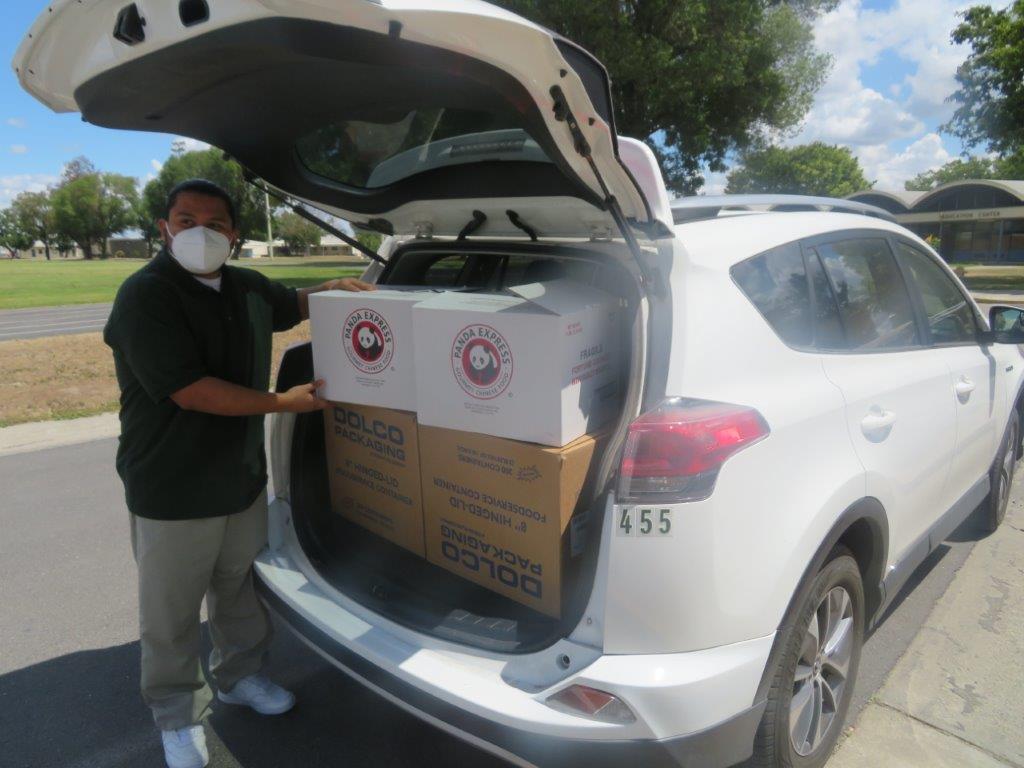
Two fundraisers held at O.H. Close Youth Correctional Facility (OHC) netted more than $2,500 to help victims of crime. The fundraisers were held in conjunction with National Crime Victim’s Rights Week, during the last week of April. Conflict Resolution Team member Jonathan Heerema and Senior Youth Correctional Counselor Wilford Francisco organized the events. One, an Asian fast food fundraiser, netted $1,732. The other, a doughnut fundraiser, raised $840. The funds will be deposited into the Victim’s Fund Account at OHC, the proceeds of which are traditionally donated to suitable San Joaquin County nonprofit organizations.
Parole Operations
DAPO agents talk CDCR careers with high school students

Capitol District Administrator Michelle Lewis and Parole Agent Supervisors Anthony Quintana, Clint Cooley, Antonio Torres, Wendy Correll, Martin Kis, Gerard Morita, and Eric Sakazaki participated in Career Day at the Galt Joint Union School District held at Galt High School.
This event provided information to high school students and community members who may be interested in pursuing a career in corrections and parole. The supervisors were split into two teams to participate in the event and interacted with students and community members of Galt. They were able to talk about the requirements it takes to be a parole agent, along with the many roles and responsibilities of being a parole agent.
The overall event was very positive and informative for both the students and community members.
Rehabilitation
DRP presents at Workforce Conference
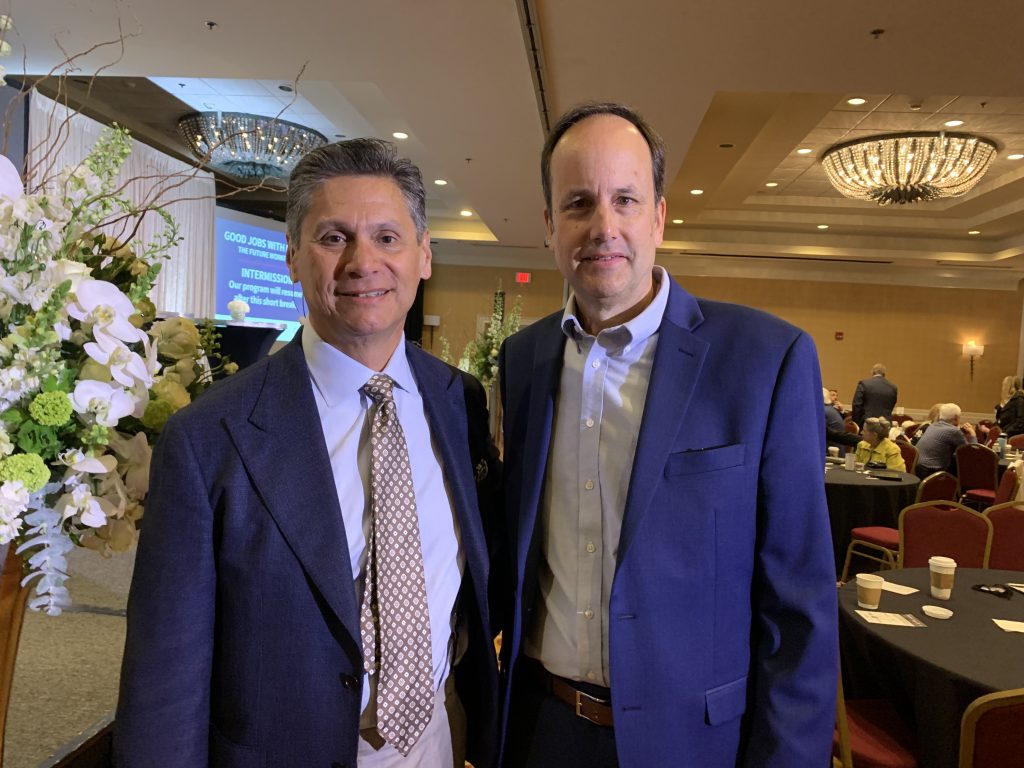
Dr. Brant Choate, Director of CDCR’s Division of Rehabilitative Programs (DRP), spoke at the “Good Jobs With Equity: The Future Workforce” conference, sponsored by the Community College Chancellor, Kern County Community College District, and the California Workforce Development Board. The audience of over 500 adult educators learned how CDCR is preparing people for the workplace upon release. Choate is pictured here with Community College Chancellor Eloy Oakley.
In Our Institutions
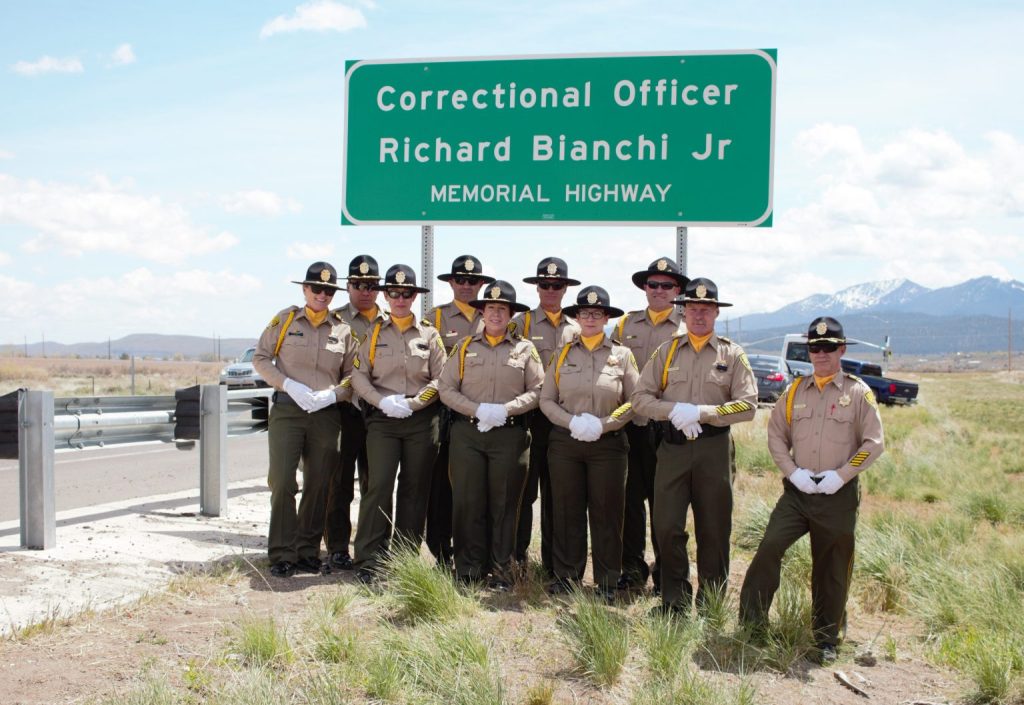
Highway dedicated to fallen officer
On Monday, May 2, High Desert State Prison (HDSP), California Correctional Center (CCC), California Correctional Peace Officers Association (CCPOA), and California State Assemblywoman Megan Dahle participated in the dedication of California Highway 36 to Richard Alan Bianchi Junior and family in Lassen County.
Bianchi, a 10-year CDCR veteran, was assigned to High Desert State Prison. While traveling to a hospital to provide security coverage on June 25, 2020, he died in the line of duty.
He was an accomplished cross-country runner and wrestler, according to friends. Bianchi also proudly served in the United States Air Force.
Bianchi is most remembered for his ability to lead by example. Friends, family and coworkers said he was admired and appreciated for his kindness, generosity of spirit, love of family, optimism and passion to make the world a better place.
Bianchi is survived by his wife of 25 years, two children, a grandson, parents, and numerous aunts, uncles, nieces and nephews.
The Highway 36 memorial sign is located near Susanville.

SAC hosts motorcycle event
California State Prison, Sacramento (SAC) welcomed Bill Glass’ Behind the Walls organization. More than 50 Bill Glass volunteers came with the intention to touch the lives of as many incarcerated people as possible in a positive way.
The event included two guest speakers to share a positive message to the population. In addition, 12 motorcycles were on display for their viewing enjoyment. Guest speakers included Christian Maynor and Mark Maciel. Maynor is a Christian rapper from Cleveland, Ohio, who has five studio-recorded albums. He rapped for the population and shared his story of rehabilitation. Maciel spoke and shared his own story as he was once an All-American wrestler who turned to drugs, gangs and prison life. He is currently the head chaplain of the Los Angeles County Sheriff’s Department. After the guest speakers concluded, attendees were given the opportunity to speak with the volunteers. Incarcerated people were able to share their personal stories and their current path to rehabilitation.
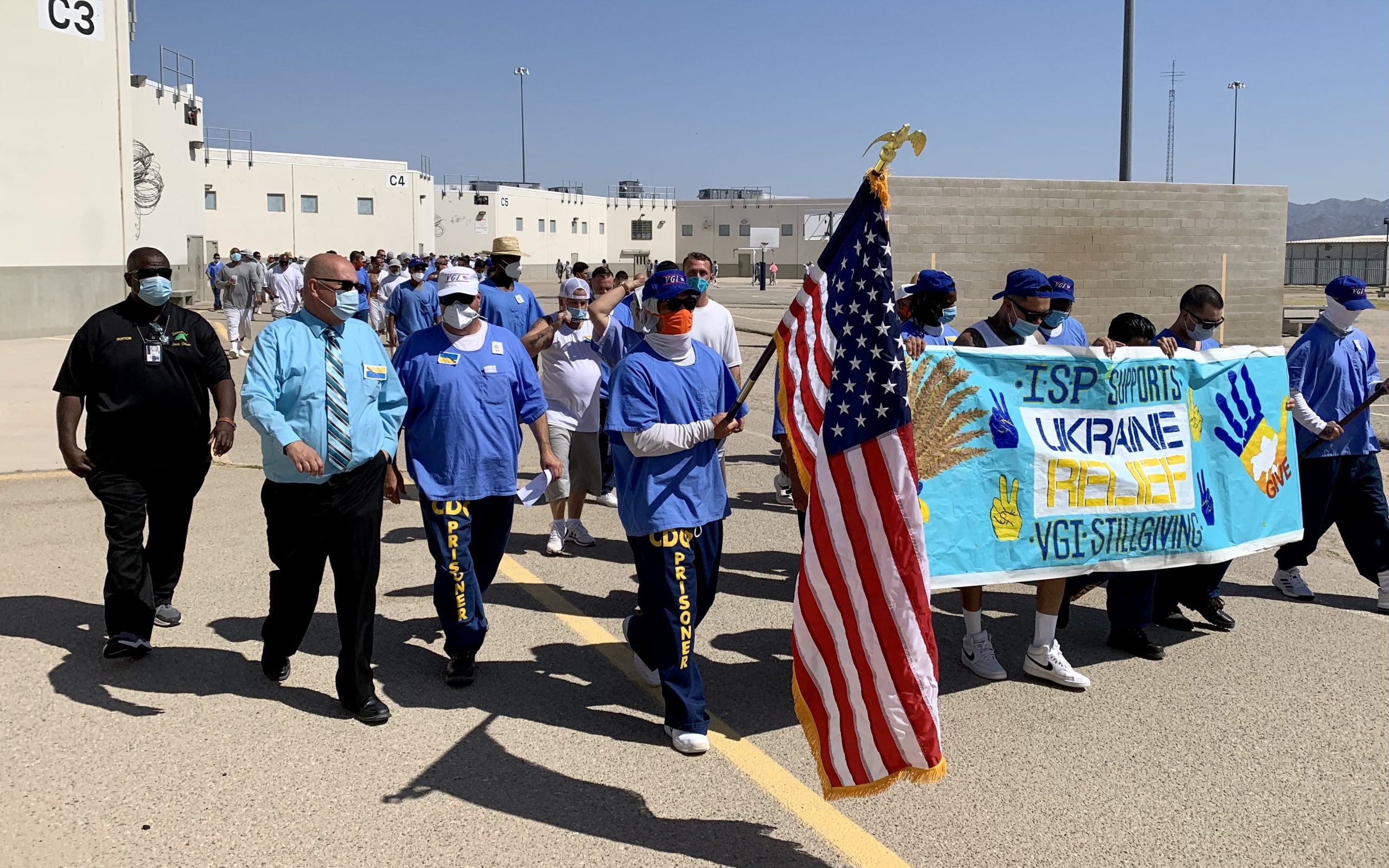
ISP holds Ukrainian relief walk fundraiser
Warden Neil McDowell and Chief Deputy Warden John Merchant, the population and staff throughout Ironwood State Prison (ISP) participated in a Ukrainian Relief Walk to support the victims of the war in Ukraine. The population submitted themed artwork in support of the cause and National Crime Victim’s Rights Week, for an art contest. The Ironwood Veterans Inmate Activity Group sponsored the event and assisted in circulating informational flyers and trust withdrawal forms to help raise the money – $2000 has been collected so far, and more continues to come in. The money raised will be evenly distributed to three vetted charities: UNICEF USA, Americares, and Operation Blessing International.
Community Resource Manager (CRM) Carey Ochs stated, “The idea to hold this fundraiser came from the population. They truly wanted to help be a part of something greater than themselves and help those in need. The event was a huge success and the artwork submitted was beautiful.”
Warden McDowell stated, “I am proud of our institution and to be able to support such a noble cause.”
In the Media
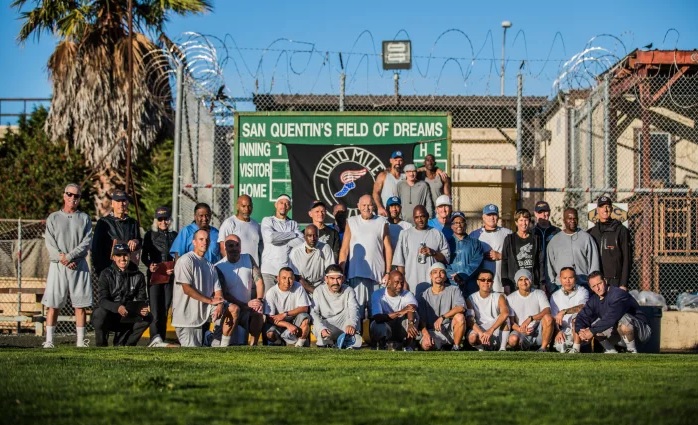
Essay: San Quentin 1000 Mile Club An Escape From Feeling the Heavy Weight of Hate
I begin my day next to a baseball scoreboard, beneath a gray sky and a sun just poking out through the marine layer that blankets the San Francisco Bay. I stretch my calves and hamstrings and simulate a few strides. I take a few deep breaths and expel them from my lungs.
I look around and I see John, Darren, Mike and Tommy, who are some of my white teammates, already out on the track. I smile and greet each of them as I set out for a five-mile run beneath the gun towers on the lower yard at San Quentin State Prison.
California Correctional System Touts Energy-Saving Efforts
The California Department of Corrections and Rehabilitation (CDCR) used this year’s Earth Day celebration to tout its sustainability program, which has the system on pace to produce a quarter of its energy needs from renewable sources by 2025.
During the last nine months, CDCR has reduced water use at its facilities by about 9 percent. The completion of water conservation projects at four different facilities are projected to reduce annual water use in the system by 66 million gallons.
The water conservation project is the latest accomplishment from a program that started five years ago, concentrating on making the system more energy efficient.
Inside CDCR Top 5
#1 with 5,364 views: CDCR recognizes National Correctional Officers Week
#2 with 3,247 views: CDCR joins other agencies for May 7 job fair
#3 with 2,686 views: Parole agents target Fresno gang violence
#4 with 1,806 views: CDCR runners brave heat for Challenge Cup Relay
#5 with 1,483 views: Rehabilitation through skilled trades
Social media
